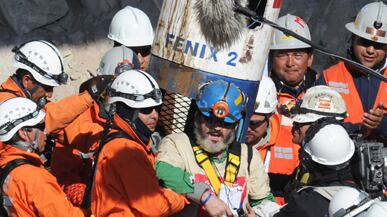In a dramatic rescue, crews pulled Luis Urzua, 54—the last of the 33 miners who'd been trapped underground for more than two months, and the group's defacto captain—to safety Wednesday night, where he was greeted with joyous cheers from friends and family.
Plus, from the wife who refused to watch the rescue to the miner dubbed the “Chilean Forrest Gump,” read six subplots from the dramatic rescue.
For a day and a half, people who usually read and hear very little about this resilient South American country found themselves transfixed by the story of the miners’ rescue. But across the Spanish-speaking world, the saga gave shape to a sort of kinship inspired by a common ancestry, a sense of unity that spread from Spain to Santiago to the boroughs of New York. For the past two months, the world’s Spaniards and Latin Americans have been locked on to the developments in Chile; coverage on Spanish-language newspapers, TV, and blogs has been nearly constant. This week, the Hispanosphere finally got the happy ending to the story that it had been waiting for. Here’s our roundup of what some of the Spanish-language press are saying today.
Gallery: Chilean Mine Rescue

Leaders: We Followed the Ordeal “As If It Were Our Own”
Leaders from across the region have expressed their support and hearty congratulations to Chilean President Sebastián Piñera, making headlines in their respective countries. Peruvian president Alan García called the rescue a “miracle,” and proof of “the presence of Christ.” From Tegucigalpa, Honduran president Porfirio Lobo Sosa wrote that his country “has followed this ordeal as if it were our own.” Well-wishes were also sent from the Dominican Republic, Spain, Brazil, Colombia, and even the ever-vocal Venezuelan Hugo Chavez, who has frequently found himself at odds with Piñera. “I hope he enjoys his trip to Europe and Asia, and I’ll see him in Guyana,” said Piñera of his Venezuelan counterpart, who is about to embark on a tour of Russia, Iran, Syria, Libya, and other countries.
The Love Triangle Worthy of a Telenovela
Ever since the news broke in September about the dramatic meeting of miner Yonni Barrios’ wife and mistress, the Latin American press has followed the subplot aggressively. So of course, when news of an imminent rescue began to spread, Barrios’ scorned wife, Marta Salinas, became an instant protagonist. Barrios is known as “the doctor” of the group because the medical skills he learned by caring for his diabetic mother have helped him administer medication to his colleagues. The question was on everyone’s minds: Which of the two women will be the one to embrace Barrios when he emerges from the capsule? Yesterday, we got our answer: the mistress. Hell hath no fury like a wife embarrassed on worldwide TV, and although Salinas claims to have received almost 60 apologetic letters from Barrios, she vowed not to even watch the rescue from her living room. “It’s been 28 years,” she said of their marriage, adding that “if he wants to start a new life with her, well good for him.”
• Why the Miners Don’t Have Beards• 8 Innovations That Saved the Miners Leaders from across the region have expressed their support and hearty congratulations to Chilean President Sebastián Piñera, making headlines in their respective countries. Peruvian president Alan García called the rescue a “miracle,” and proof of “the presence of Christ.” From Tegucigalpa, Honduran president Porfirio Lobo Sosa wrote that his country “has followed this ordeal as if it were our own.” Well-wishes were also sent from the Dominican Republic, Spain, Brazil, Colombia, and even the ever-vocal Venezuelan Hugo Chavez, who has frequently found himself at odds with Piñera. “I hope he enjoys his trip to Europe and Asia, and I’ll see him in Guyana,” said Piñera of his Venezuelan counterpart, who is about to embark on a tour of Russia, Iran, Syria, Libya, and other countries.
Chileans in America Connect With Their Homeland
According to the 2000 census, an estimated 69,000 Chileans live in the U.S. This community, which was quick to respond in the aftermath of the earthquake that struck the country in February, has followed the news of the rescue closely. They have also told Spanish media that they are proud of how these events have showcased their nation’s strength and resilience. “We are proud, and touched, by the outpouring of support we have received throughout this experience,” said Monica Kinney, a spokeswoman with the Chilean Cultural Corp. in Washington, D.C. Verónica Fernández, director of Agrupación Chile, also in Washington, said, “The level of planning, organization, and attention to detail has set an example not just for our people, but for the rest of the world.”
The Chilean Forrest Gump
A Guatemalan newspaper ran a profile of Edison Peña, whom they dubbed “ the Forrest Gump” of the group. The 34-year-old Peña, who suffers from hypertension, diabetes, and hearing problems, asked for running shoes and shorts as soon as he was able to make contact with the outside world. “I get very anxious, and I need to run,” said Peña in a letter to his girlfriend, Angélica Ivarez. “I picture us making trips to the beach, going camping, everything. I want to be free, I want to see the sun.” he said in his letters. He was pulled out on Wednesday at 10:11 a.m. local time, and was greeted by President Piñera, along with his Bolivian counterpart, Evo Morales. “You’re a big man, Edison, a big man!” said Piñera as he hugged him, while the rescued miner kept repeating “We’re alive!”
Mexico Remembers Its Dead Miners
As they watched the rescue in Chile, Mexicans could not help but remember the 2006 disaster that left 65 of their own miners dead—63 of them buried inside because not even their bodies could be recovered. Columnist Fernando del Paso penned a scathing article, saying it is both wondrous and shameful to see what is happening in Chile. “Here,” he said, “we didn’t lift a finger, we didn’t even try—not even modestly—to save the life of at least one of our miners in Pasta de Conchos.” Meanwhile, a Catholic bishop, Raúl Vera, has called for a reopening of the investigation into the Pasta de Conchos debacle. The bishop said the country’s attorney general should file charges against the former minister of labor, the current one, the authorities who were in charge when the accident occurred, the people in charge of the original investigation, and the people who ran the mine.
As the Miners are Rescued, So Is Their President
In Argentina, the newspaper of record, La Nación, has an interesting analysis, saying that the first to have been rescued was actually Chilean President Piñera himself. “He had a certain lack of charisma,” says the newspaper, adding that his style of governance seemed to be misunderstood by most of the population. The day of his inauguration, for example, he chose not to stay and have lunch with the regional leaders that traveled to attend the event. Instead, he got in a helicopter and traveled to the region that was hit hardest by the earthquake. The gesture backfired, and confused people across the country who thought he had been rude to his counterparts. Before the mine accident, his popularity was declining, and his efforts to revitalize the nation’s economy had not been fully appreciated. When the mine collapsed, he was traveling through Ecuador and Colombia. He heard of the accident and dismissed the advice of the people closest to him, deciding instead to jump right in and take a central role in the rescue efforts. “This was a pivotal moment in his presidency,” says La Nación, “and one that has finally gotten him the gratitude of his countrymen.”
Constantino Diaz-Duran has written for the New York Post, the Washington Blade, and the Orange County Register. He lives in Manhattan and is an avid Yankees fan. You'll find him on Twitter as @cddNY.





